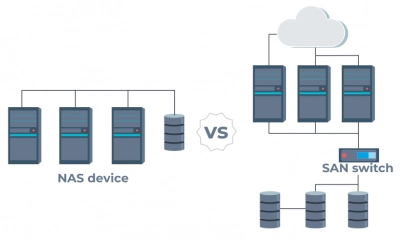SAN storage vs NAS storage
In this article you would find out:
- what is NAS
- NAS Limitations
- what is SAN
- SAN Pros and Cons
- NAS vs SAN Comparison
- NAS as a file server
- Difference Between SAN and NAS

Are you read? Let's read!
What is NAS (Network Attached Storage)?
A network-attached storage (NAS) device connects to your home network, offers file storage services, and makes all of your data available from any device. NAS hardware is excellent for usage in both offices and homes. They give many users in various places an easy method to access data (to trade information, collaborate on various projects).
You can dependably prevent data loss in the case of an HDD failure by using numerous drives, and you'll always have access to your information. Additionally, this storage option is inexpensive, and you can quickly expand the amount of free space if needed.
Easy to install and deploy NAS make this device very attractive for all users. It looks like this:
All NAS volumes appear to the user as connected to the network, and files are stored on one or more hard drives in the system, most often at one of the RAID array levels. The more drive bays your NAS has, the more storage options you have.In this case, the device itself is a network node, and the NAS uses an Ethernet network to send and receive files.
The only negative phenomenon that you may encounter is that with a large influx of requests, the server may not be able to cope with this and performance will be reduced for a while. Therefore, if the server is not overloaded, there will be no problems at all, and if you use thin software to transfer information, then the NAS will have even more advantages.
Benefits of NAS
Here are a few arguments in favor of considering network connected storage.
1. Centralized file access and storage
If you utilize NAS for file storage, you can remotely access any data you need from your desktop computer or when you're away from the workplace. This implies that if you wish to work on the files from home, you won't have to waste time continuously emailing them to yourself. Additionally, if you are on the road and at a client meeting, you may access any sales materials you need remotely.
By consolidating file storage, you may increase security and decrease the possibility of losing files. On NAS, it's simple to set up file access rights that guarantee that only people with the right authorization can access a certain file or folder.
2. Backup to a Local Cloud That Is Automated
For PCs and mobile devices that are kept on-site or off-site, network attached storage devices provide you economical backup solutions that can serve as a cloud backup. You have additional options for ensuring data is safely backed up and accessible when you need it when backing up office computers since you can pick between backing up wirelessly or via an Ethernet cable connection.
3. Simple to Install and Use
NAS devices are made to be user-friendly and straightforward to set up. The setup process won't take you hours, and Quantum PC Services will set up your NAS and connections for you to make things even simpler.
Access is also made to be user-friendly and usually involves a web-based interface to make file access uncomplicated.
4. Reduced Hardware Costs
If you keep all of your data on a NAS, your work PCs won't need as much storage space, allowing you to choose less expensive hard drive options. These hardware cost savings could accumulate to a substantial sum over time.
5. Compact and Room-saving
You won't need to set aside a lot of workplace space if you use NAS. Some NAS devices aren't much bigger than a toaster, however sizes vary according to capacity. Because of this, if you need to get them out of the office before a storm, they are not only useful but also easy to transfer.
6. Affordable File Storage for Homes & Offices
NAS is a reasonably affordable option for private cloud file storage for both homes and small businesses. The beginning prices of the top NAS solutions, as assessed by PC magazine, are under $200, making them accessible to many people who need easier access to their data and the security of a local backup.
NAS Limitations
With NAS, you may have questions about scaling and performance. As mentioned above, the server may not have time to respond to requests from a large number of users. Of course, you can expand the storage, however, in reality, you will most likely need to use a more powerful system with a larger embedded processor with faster and larger network connections.
In addition, Ethernet itself transfers data from one place to another, dividing the source into several segments (packets). Depending on network traffic, any of these packets may be delayed / sent out of order and the file will not be available until all packets have been delivered to their destination.
This only becomes a significant problem in complex environments where there are huge files and latency of more than a few milliseconds can disrupt production.
In other cases, such delays do not really matter and may not be noticed at all.
Best Hard Drive For NAS
When selecting a hard drive for a NAS (Network Attached Storage) system, there are several factors to consider to ensure optimal performance and reliability. Here are some key points to keep in mind:
1. Compatibility: Check the compatibility of the hard drive with your specific NAS device. Most NAS systems support both 3.5-inch and 2.5-inch hard drives, but it's essential to verify the compatibility beforehand. Additionally, consider the interface type (SATA or SAS) supported by your NAS and choose a drive accordingly.
2. Drive Type: There are two primary types of hard drives commonly used in NAS systems: desktop-grade drives and enterprise-grade drives. Desktop-grade drives are more affordable and suitable for home or small office NAS setups with lighter workloads. Enterprise-grade drives, on the other hand, are designed for heavy workloads and continuous operation, making them ideal for business environments. They are more expensive but offer higher reliability and better performance.
In terms of specific hard drive models, some popular options for NAS usage include Western Digital Red, Seagate IronWolf, and Toshiba N300. These drives are specifically designed for NAS systems and come with features like vibration control, optimized firmware, and higher durability.
Ultimately, the best hard drive for your NAS will depend on factors such as your budget, storage capacity requirements, workload intensity, and the level of data redundancy you desire. It's advisable to consult your NAS manufacturer's recommendations and user forums to gather insights and experiences from other users before making a final decision.
What is SAN (Storage Area Network)?
SAN is all about providing users with high-performance storage sharing with minimal latency. It consists of a combination of servers and storage over high-speed, low-latency interconnection. Here, there is a direct Fiber Channel connection from the client to the storage volume to provide the highest performance. Direct Fiber Channel connectivity avoids TCP / IP bundling issues and latency, LAN congestion - delivering the fastest access speeds available for media and mission-critical data storage.
SAN provides shared storage for users in demanding applications. For even greater performance, the SAN can request a separate private Ethernet network between the server and clients. This is to keep file request traffic out of the Fiber Channel network.
NAS vs SAN Comparison
The main disadvantages of SAN are its complexity and cost. This requires both a separate Ethernet network for metadata file requests and a Fiber Channel network to be provisioned and maintained. It is not only difficult from the point of view of implementation, but also from the monetary side. However, this is the only way to provide high-speed data access for a large number of users, which can instantly scale to support hundreds of users simultaneously.
For a better understanding of the differences between NAS and SAN, let's start comparing them.
- The NAS is intended for home use or small and medium-sized businesses.
- SAN is designed for professional and corporate environments.
- NAS is inexpensive, easy to manage, and SAN is expensive and requires additional administration.
- NAS speed depends on the TCP / IP Ethernet LAN and the number of other users accessing the storage at the same time. SAN provides consistent high speed using Fiber Channel, and Fiber Channel can be delivered over high speed Ethernet using protocols such as FCoE and iSCSI.
- NAS supports SMB / CIFS, SFTP, NFS, and WebDAV, while SAN supports Fiber Channel, FCoE, and iSCSI.
- For NAS, high-performance NAS scalability to petabytes is possible using clusters or scale-out nodes. SANs have the ability to add additional storage controllers, allowing SAN administrators to scale performance and storage capacity.
Based on the aforementioned significant differences between NAS vs SAN, we can conclude that NAS is easy to set up, easy to administer, and great for common general purpose applications. And SANs are best used for mission-critical and high-performance applications, so configuration and administration will be much more difficult here.
Based on the presented table, we can conclude that NAS is easy to configure, to administer, and is great for common general-purpose applications. And SANs are best used for mission-critical and high-performance applications, so configuration and administration is much more difficult.
Differences Between NAS and SAN
| NAS | SAN |
| Typically used in homes and small to medium sized businesses. | Typically used in professional and enterprise environments. |
| Less expensive | More expensive |
| Easier to manage | Requires more administration |
| Data accessed as if it were a network-attached drive (files) | Servers access data as if it were a local hard drive (blocks) |
| Speed dependent on local TCP/IP usually Ethernet network, typically 100 megabits to one gigabit per second. Generally slower throughput and higher latency due to slower file system layer. | High speed using Fibre Channel, 2 gigabits to 128 gigabits per second. Some SANs use iSCSI as a less expensive but slower alternative to Fibre Channel. |
| I/O protocols: NFS, SMB/CIFS, HTTP | SCSI, iSCSI, FCoE |
| Lower-end not highly scalable; high-end NAS scale to petabytes using clusters or scale-out nodes | Network architecture enables admins to scale both performance and capacity as needed |
| Does not work with virtualization | Works with virtualization |
| Requires no architectural changes | Requires architectural changes |
| Entry level systems often have a single point of failure, e.g. power supply | Fault tolerant network with redundant functionality |
| Susceptible to network bottlenecks | Not affected by network traffic bottlenecks. Simultaneous access to cache, benefiting applications such as video editing. |
| File backups and snapshots economical and schedulable. | Block backups and mirrors require more storage. |
Should You Choose a NAS or a SAN?
The distinction between storage area network and network attached storage is obvious: SAN is a network of devices that behave as one, whereas NAS is an endpoint device. Buying and maintaining a network area storage device is more easier and less expensive. A storage area network takes expertise, skill, and ongoing maintenance to set up. Building one is also expensive.
You should use a NAS if you require storage for backup or data exchange among small groups. Hire a professional to create you a SAN if you demand high input/output speeds and have servers and apps that must connect with one another.

